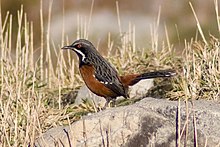Rockjumper
| Rockjumpers | |
|---|---|

| |
| Cape rockjumper (Chaetops frenatus) | |
| Scientific classification | |
| Domain: | Eukaryota |
| Kingdom: | Animalia |
| Phylum: | Chordata |
| Class: | Aves |
| Order: | Passeriformes |
| Family: | Chaetopidae Fjeldsa, Ericson, Johannson, & Zuccon, 2015 |
| Genus: | Chaetops Swainson, 1832 |
| Species | |
|
| |
The rockjumpers are medium-sized insectivorous or omnivorous birds in the genus Chaetops, which constitutes the entire family Chaetopidae. The two species, the Cape rockjumper, Chaetops frenatus, and the Drakensberg rockjumper, Chaetops aurantius, are endemic residents of southern Africa.[1] The Cape rockjumper is a resident of the West Cape and south-west East Cape, and the orange-breasted (or Drakensberg) rockjumper is distributed in the Lesotho Highlands and areas surrounding them in South Africa. The two rockjumpers have been treated as separate species but differ in size and plumage. The ranges do not overlap, but come close to doing so. Also found in the mountain of a small town Middelburg in the eastern Cape where they are protected because they are endangered species. [citation needed]
Taxonomy and systematics
Originally, these birds were placed in the
Their Latin names derive from descriptions of their appearance. "Frenatus" refers to the "bridled" or black-and-white head pattern, while "Aurantius" refers to the orange coloration.
Description
These are small birds with mostly black, white, and red plumage. Both species have long, white-tipped black tails, black throats, broad white submoustachial lines and eyebrows, rufous or orange bellies and rumps, and grey and black patterned backs and wings. Females have a similar pattern to males, but duller.[1] The iris is red and the bills and legs are black. Their wings are very small and they do not fly very often. They spend most of their lives running and jumping among rocks and grass while hunting insects.
Behaviour and ecology
Diet and feeding
The rockjumpers feed in groups, foraging on the ground. The groups can number up to 6 birds (for Cape) and 12 birds (for Drakensberg), but the groups may also spread out quite widely during feeding.[3][4] Insects are the major part of the diet, although small vertebrates are reported to be taken by Cape rockjumpers.[3] A range of insects are taken, including caterpillars, moths, grasshoppers, beetles and flies. In addition to insects other prey include lizards and geckos, amphibians, scorpions, annelid worms and spiders. Crows often attack the birds because they both eat similar foods, crows would traitor them until they leave the food alone .
Breeding
They are
References
- ^ ISBN 978-84-96553-42-2
- ^ Oliveros et al. 2019
- ^ a b Collar, N., Robson, C. & Sharpe, C.J. (2017). Cape Rockjumper (Chaetops frenatus). In: del Hoyo, J., Elliott, A., Sargatal, J., Christie, D.A. & de Juana, E. (eds.). Handbook of the Birds of the World Alive. Lynx Edicions, Barcelona. (retrieved from http://www.hbw.com/node/59691 on 4 July 2017).
- ^ Collar, N. & Robson, C. (2017). Drakensberg Rockjumper (Chaetops aurantius). In: del Hoyo, J., Elliott, A., Sargatal, J., Christie, D.A. & de Juana, E. (eds.). Handbook of the Birds of the World Alive. Lynx Edicions, Barcelona. (retrieved from http://www.hbw.com/node/59692 on 4 July 2017).
- 2.0.CO;2]
- ISBN 1-55297-777-3.
